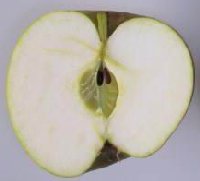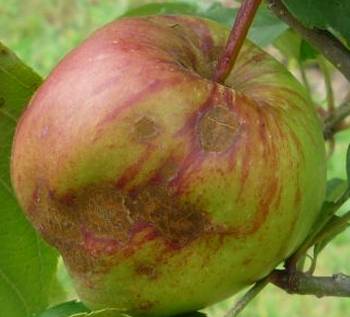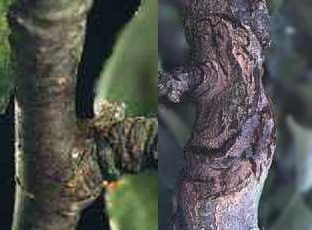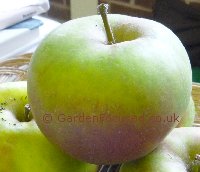PARENTAGE
The parents of the Blenheim Orange are unknown, it was first identified some time around 1740 in Woodstock, Oxfordshire. It takes its name from the nearby Blenheim Palace.
APPEARANCE, TASTE AND CHARACTERISTICS
The apples are slightly larger than normal and the shape is rather flattened. The skin is moderately russeted and has a green and yellow to orange colour with some rather feint red streaking to it. The apples are used both for cooking and as a dessert apple. Great in apple pies because it cooks down to a nice puree with some body to it. For cooking purposes the apples should be used from early October, for eating it’s best to leave them a month or so longer to develop a sweeter flavour.
Blenheim Orange is triploid which has a couple of implications if they are to produce a good crop of apples. Triploid apple trees cannot pollinate other apple trees, nor can they pollinate themselves.
This may sound daunting but in most urban areas this is not a problem at all, nearby apple trees in other gardens and parks will do the job fine. Check our list of pollination partners for Blenheim Orange below for more details if you are in doubt. This apple tree is in pollination group 4.
Blenheim Orange is a very vigorous growing tree and this is one reason why it should be grown on a dwarfing rootstock. For most medium-sized gardens we would suggest growing it on an MM106 or M9 rootstock. For the majority of apple tree varieties this would result in a tree just over 2.6m / 9ft high but with this variety the tree will grow to about 4m / 13ft high, slightly less if pruned to restrict its size.
If you cut the apple in half the flesh is a creamy yellow colour. Bite into it and the texture is slight crumbly rather than over-crisp with a distinctly nutty flavour typical of many older apple varieties.
The original tree was grown as a seedling and it would seem that pips from tree are more than normally likely to grow true to type or nearly so. There are several mutations of the original tree which are sold as Blenheim Orange and they tend to have a redder skin but the main characteristics of large size, texture and taste generally remain the same.

BLENHEIM ORANGE PESTS AND DISEASES
Blenheim Orange is an old triploid variety and has reasonably good pest and disease resistance. It definitely shows significant resistance to powdery mildew and is rarely troubled by bitter pit. However it also has a weakness for both scab and canker. Identifying and treating both these conditions is described below
SCAB
This is a fungal disease which primarily affects the leaves, fruit and the general health of the tree. In spring the leaves have small yellow patches on them which soon turn brown. In July / August the leaves fall prematurely and prevent the fruits from developing correctly.


A leaf infected with Scab
The fruits are also commonly affected and will have greyish, slightly raised or sunken areas on the surface. This affected area will not grow with rest of the apple causing it to split eventually, providing an ideal site for other infections to enter.


An apple fruit affected by scab
Apples with scab are safe to eat, simply cut out the affected surface area. The surface damage will however, affect the storage life which will be minimal. So eat apples affected by scab before eating ones in good condition.
The primary treatment for the home gardener is to pick up and destroy all fallen leaves and fruit because these contain the spores which will cause re-infection next year. There are no longer any chemical sprays available to the UK gardener for treating scab on apple trees where the fruit will be eaten. Click here for more detailed information on identifying and treating apple scab.
CANKER
Even if you grow this variety of apple tree in a relatively dry part of the UK, canker will always be a risk. It damages the bark of the tree and the only solution is to cut it out as soon as as you notice it. Early action reduces the risk of further infections. See the picture below:

Canker damage to a fruit tree
For more information about identifying, treating and avoiding canker see our dedicated page for this disease here.
For a full description of common apple pests and diseases click here.
BUYING A BLENHEIM ORANGE APPLE TREE
This variety is not one of the top ten sellers in the UK and although we have seen it for sale once at a supermarket (discounted price), in general you will need to buy online, at some large garden centres or from a specialist nursery.
SUMMARY CHARACTERISTICS OF BLENHEIM ORANGE
USE: Dual purpose cooking and eating
SKIN COLOUR / TEXTURE: Slightly russeted, yellow / orange background with some red streaks
FLESH COLOUR: Cream
TASTE AND TEXTURE: Slightly nutty taste, crumbly rather than crisp texture
FRUIT SIZE: Slightly larger than average
SUITABILITY FOR CORDONSPALIER GROWTH: Definitely not suitable
TREE SIZE: A very vigorous grower producing a very large tree
REGULARITY OF CROPPING: Likely to miss a year every three or four years
POLLINATION: Group 4, triploid, needs a pollination partner, will not pollinate other varieties
AWARDS: RHS AGM in 1993
SPECIAL FEATURES: Especially good in cooler parts of the UK. This is a partial tip bearing apple tree and should be pruned infrequently. See here for more advice on pruning partial tip bearing apple trees. Good resistance to apple scab.
FLOWERING AND HARVEST TIMES:
The average flowering time (optimum time for pollination) and date when fruits are ripe in the UK for the Blenheim Orange apple tree are set out below. If you have set your home town we can give you a more accurate estimate, if you have not set your home town (do it now by clicking here) the dates below will be the average for the UK.
Your town has not been set, the average main flowering time for Blenheim Orange
in the UK is the second week of May. Fruit will be ready for harvesting in the first week of October.
Click here if you want to set the dates to your home town.
Flowering and fruit picking dates vary according to the weather in any particular growing season so the above dates may well change slightly from one year to the next. The flowering date above is when the apple tree produces the maximum number of blossoms, it will also produce blossom, although less, a week or two either side of the date given.
BLENHEIM ORANGE POLLINATION
We list below varieties which are suitable pollination partners for Blenheim Orange which is in pollination group 4 and self sterile (also a triploid).
- Arthur Turner – pollination group 3, self-sterile, cooker
- Bountiful – pollination group 3, self-sterile, cooker
- Braeburn – pollination group 4, self-fertile, eater
- Charles Ross – pollination group 3, partially self-fertile, cooker and eater
- Court of Wick – pollination group 3, self-sterile, eater and cooker
- Coxs Orange Pippin – pollination group 3, partially self-fertile (see here), eater
- Discovery – pollination group 3, self-sterile, eating and cider
- Dumelow’s Seedling – pollination group 4, self-sterile, cooker
- Ellison’s Orange – pollination group 4, partially self-fertile, eater
- Emneth Early – pollination group 3, partially self-fertile, cooker
- Epicure – pollination group 3, self-fertile, eater
- Falstaff – pollination group 3, self-fertile, eater
- Fiesta – pollination group 3, partially self-fertile, eater
- Gala – pollination group 4, partially self-fertile, eater
- Golden Delicious – pollination group 4, partially self-fertile, eater and cooker
- Granny Smith – pollination group 3, self-fertile, eater and cooker
- Grenadier – pollination group 3, partially self-fertile, cooker
- Honeycrisp – pollination group 4, self-sterile, eater
- James Grieve – pollination group 3, partially self-fertile, cooker and eater
- Katy – pollination group 3, self-sterile, both
- Kidds Orange Red – pollination group 3, self-sterile, eater
- King of The Pippins – pollination group 4, partially self-fertile, eater and cooker
- Lanes Prince Albert – pollination group 4, self-sterile, cooking
- Laxtons Fortune – pollination group 3, partially self-fertile, eater
- Laxtons Superb – pollination group 4, partially self-fertile, eater
- Lord Derby – pollination group 4, self-sterile, cooker
- Merton Beauty – pollination group 5, self-sterile, eater
- Peasgoods Nonsuch – pollination group 3, partially self-fertile, cooker
- Rajka – pollination group 4, self-sterile, eater
- Red Falstaff – pollination group 3, partially self-fertile, eater
- Scrumptious – pollination group 3, self-fertile, eater
- Sops in Wine – pollination group 3, self-sterile, juicer
- Spartan – pollination group 3, self-fertile, eater
- Sunset – pollination group 3, self-fertile, eater
- Tydemans Late Orange – pollination group 4, self-sterile, eater
- Winston – pollination group 4, self-fertile, eater
- Waltz – pollination group 3, self-sterile, eater
- Worcester Pearmain – pollination group 3, partially self-fertile, eater
The full list of apple tree varieties which we have reviewed is listed below. Select any one of them and then click the “More Information” button to be taken to the in depth review:

Rootstocks and Size
Guide to Planting
Care Plan
Pruning Apple Trees
Harvest and Storage
Pests and Disease
Pollination Groups
BLENHEIM ORANGE APPLE TREE
Blenheim Orange is not an apple tree for the faint-hearted being one of the most, possibly even the most, vigorous of all apple trees. Grown on its own roots this variety can reach 10 metres high (and even wider) after 40 or 50 years.
If left unrestricted on its own roots it becomes totally unmanageable as a tree for bearing fruit. The apples are too high to reach without ladders or scaffolding and it cannot be sprayed or treated purely because of its size.
It is a triploid and this means it cannot fertilise itself nor can it fertilise other apple trees.